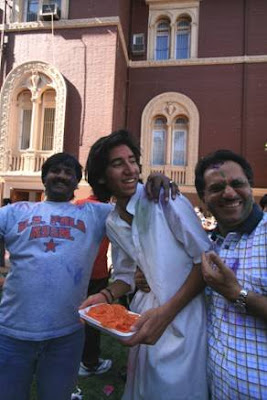This is a series of information I have been given from different sources, but its useful information and deserved a post to itself.
1. Brian : Taba Heights is a newly-constructed tourist resort just 10 minutes down the road from the Egypt/Israel border.
They have an international Marina that has direct ferries to Aqaba. Egyptian citizens are not allowed on the ferry and I'm not too sure about recent prices, but it's definitely a whole lot easier/quicker than going through Israel or fighting through Nuweiba.
2. Andy :
seat61.com is one of the most valuable websites in existence. Train/bus schedules for every country including Israel/Jordan
Here's a good website:
http://www.jordanjubilee.com/For your route check this page:
http://www.jordanjubilee.com/travelme/sinai.htmSince I've never traveled there myself though, I'm not sure about the veracity of the info. A couple comments though about this page....
From what I heard, Israeli border people randomly stamp about 10% of passports, even if you specifically request them not to. Also, I have heard that the Egyptians at Taba WILL stamp a separate page in your passport if you ask them. So if you don't mind an Israeli stamp, or if you wanna take the risk to save a few $, you could travel by land through Israel.
Otherwise, I'd recommend the boat Nuweiba to Aqaba.
One more thing: I've heard that if you have an Egyptian Iqama for non-Touristic purposes, you can re-enter Egypt on the same Iqama, with no need for re-entry stamps. If your Iqama is for Touristic purposes, you need to go to the Mogama for re-entry stamps, or get another Egyptian visa (hopefully in Aqaba or Amman, because getting one int Tel Aviv or Eilat would again say "Egpytian Embassy Tel Aviv" and thus show evidence of travel to Israel).
3. Corrado : The re-entry stamp is anonymous, even if you ask to do it on a private paper, but actually I won't be surprised if anything changed after what happened in Rafah during January, so would be a good idea to ask to the Israeli Embassy each time you travel. Anyway you don't need a second passport to go back to Egypt, for sure.
There is a bus leaving twice per week from Sheraton Hotel at 8:00. It stops in Tel Aviv (12 hours) and Jerusalem (15 hours) , with extra stops included (so please consider two or three extra hours). the price is 80 dollars to Jerusalem (two way trip).
Another way would be go to the border (Taba, the only opened one) and take a taxi to cross the border, then a bus to cross the Negev. It would be more stressing, but cheaper.
4. I walked across the border from Eilat, Israel, to Taba, Egypt. It is true for Syria, Lebanon, Libya, Sudan, Saudi, etc. you can ask for it not to get stamped. they will (probably) comply. probably.
5. Dan : A few old colleagues of mine had gone through a sponsored delegation about a year ago.
www.ffipp.org You can google the organization and search for more details. Very organized endeavor, meet with Palestinian and Israeli peace activists and NGOs, etc.
6. Sara : According to my 2006 Jordan Lonely Planet:
"There are two boat services to Nuweiba in Egypt which leave from the passenger terminal just south of Aqaba. With both services, departure times can be subject to change so call the passenger terminal (03 2013240;
www.abmaritime.com.jo) before traveling to check departure time.
The fast boat leaves daily from Aqaba (except Saturday) at noon (gets there by 10.30am), takes about an hour and costs JD26 or US$36; children aged two to 12 pay JD14 or US$20. It's more expensive (US$45) to come the other way due to the difference in government taxes. You need your passport to buy a ticket. The return ferry leaves Nuweiba around 3pm.
There is also a slower ferry service (which doubles as a car ferry) that officially leaves at noon but often doesn't leave until 5pm or later, depending on the number of trucks trying to get on board. When it does leave, it should take three hours but it usually takes longer. There is sometimes talk of another service, at 6pm, but this is only during exceptionally busy times (like the haj). The cost for the slow ferry is US$25. A car in either direction costs an extra US$110.
Tickets for either service can be paid for in Jordanian dinars or US dollars. It's not possible to buy return tickets. Beware of buying ferry tickets in Amman because you may be charged extra for nonexistent first class seats - buy the tickets in Aqaba.....
If you are traveling from Egypt you will arrive too late for public transport to Petra or Wadi Rum so you will have to stay overnight in Aqaba or arrange for a taxi.
One thing to consider, if you don't mind an Israeli border stamp, is that it's quicker and cheaper to travel overland via Israel and the Palestinian Territories. Take a taxi from Taba to the border then another taxi on to the Arava border crossing with Jordan (or go by bus changing at the Eilat bus station); the whole thing takes about an hour. Going to Egypt bear in mind that you can't get a full Egyptian visa at the border with Israel and the Palestinian Territories at Taba, only a Sinai peninsula visa, so get one in Aqaba or Amman before you go."
7. Susan : I think we can take away a couple of relevant points from this discussion.
1) Everyone has had a different experience getting into the country, and while the majority of people have had hassles either at Ben Gurion or any of the border crossings, speculating on how or why they decide to discriminate is not getting us anywhere. They may hold you up based on the nationality of your passport, the stamps in your passport, your ethnicity, your name, presumed religion, male, female, whatever. I think it depends largely on the personalities of the border guards, their mood, how bored they are, their need for a power trip, individual reactions to the harassment... what have you.
2) While they may delay you for having a stamp from a particular country in your passport, it is unlikely that they will actually deny you entry.
I have personally flown into Ben Gurion on several occasions with stamps from many countries which would not accept an Israeli stamp, namely Yemen, Lebanon, Sudan, Kuwait. Although they personally walked me over to the "terrorist corner" as I like to call it, took my passport away (and presumably copied every page in it), and interrogated me, they eventually let me in every time.
I have never crossed into Israel at a border crossing, but based on the tales of many here, from many friends who have lived/worked there, and my personal experience in Ben Gurion, it seems that entry at Ben Gurion, while hardly a pleasant experience, is somewhat less of a hassle. On the other hand, flying out of Ben Gurion can be almost more harrowing, especially on El Al which has the most stringent security procedures of any airline I've ever flown (I do not recommend the direct flight from JFK to Ben Gurion, for example...).
The bottom line is that it can be time-consuming to get into the country, but it is really hard to generalize the reasons, and no matter what precautions you take to minimize the headache, there will be some. If you absolutely must travel there (for work or other reasons), I recommend flying in to minimize delays, and ensure that you will not get the stamp (I'm told that the "looking you directly in the eye while stamping your passport" phenomenon happens mainly at border crossings).
Although easier said than done, myself included, anticipate the delays, try to remain calm so as not to irritate them more, and take a good book...
8. Gabi : In Taba heights they organise 1 day trip to petra for their non-egyptian guests. The other side hotel (tala bay in Jordan) is owned by the same company, and there is a border crossing marine port there. (it is 24 km south to Taba and Israili borders).
you can contact them
www.tabaheights.com









































